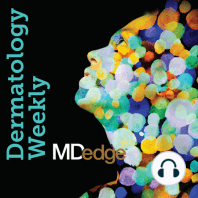31 min listen

Nemolizumab for atopic dermatitis, 1/3 of older Americans get shingles vaccine, and racial diversity in dermatology training ency
Nemolizumab for atopic dermatitis, 1/3 of older Americans get shingles vaccine, and racial diversity in dermatology training ency
ratings:
Length:
27 minutes
Released:
Jul 16, 2020
Format:
Podcast episode
Description
Dermatology residents must be knowledgeable about dermatologic conditions presenting in patients of various ethnic backgrounds. Dr. Vincent DeLeo talks to Drs. Abigail Cline, Susan Taylor, and Amy McMichael about improving and expanding multiethnic training in dermatology residency. “Now that I’m in residency, it has become very clear how different presentations in skin of color can be, and I can really see the importance of proper training in a racially diverse population,” says Dr. Cline. They discuss ways to ensure that dermatology trainees get adequate exposure to conditions affecting ethnic skin and highlight the role of the Skin of Color Society in reducing racial disparities within the specialty. * * * This week in Dermatology News: 1. Topical PDE-4 inhibitor for psoriasis effective in phase 2b trial Original story: https://bit.ly/38YtdV3 2. Subcutaneous nemolizumab eases itching for atopic dermatitis Original story: https://bit.ly/3j3U3jp NEJM article: https://bit.ly/32icCdG 3. About 1/3 of older Americans receive shingles vaccine Original story: https://bit.ly/2Cyz9rY CDC report: https://bit.ly/2WmhOJK * * * Key takeaways from this episode: There is a lack of minority representation in dermatology educational materials such as textbook photographs, which often are heavily skewed toward lighter skin types. Results from a recent survey revealed that dermatology residents in the Midwest and Northwest were not seeing a diverse patient population: “[Residents] in the Northeast, Southeast, and Southwest tended to see more diverse patients, and so they didn’t feel the need for continued lectures or skin of color clinics, but the respondents within the Midwest and the Northwest really wanted to see these patients and really wanted to see what these dermatoses look like in skin of color,” Dr. Cline explains. To ensure dermatology trainees get adequate exposure to diverse populations, home programs can allow residents to travel and rotate to other programs where they can get firsthand experience diagnosing skin of color patients. The Skin of Color Society aims to reduce racial disparities in dermatology through a variety of programs, including its annual scientific symposium, mentorship program, and research grants. Skin of color centers throughout the United States allow dermatology residents to rotate through and work with large numbers of skin of color patients. “[They also provide] an opportunity for trainees to see patients who are very satisfied with race-concordant visits—that is, the patient and the provider are of the same racial group—so they can observe what goes into making that type of interaction very successful and rewarding for the patient,” says Dr. Taylor. Practicing dermatologists can make a positive impact by mentoring high school, college, or medical students who do not have social capital as well as contributing a gift to societies with mentorship programs that provide opportunities for residents. Dermatologists can create diversity within their own practices to improve patient access to care. “You can be great at what you do, you can be a fantastic dermatologist but still not be culturally competent, so looking at what that really means—how to understand populations that are different from you culturally, how to look at perhaps having individuals in your practice that can make those patients more comfortable . . . whether they may be your nurses or your intake people . . . just sort of looking around and seeing how you can diversify your own space so that when others come they feel like you know what you’re talking about, and I think that’s really the goal overall,” explains Dr. McMichael. Hosts: Nick Andrews; Vincent A. DeLeo, MD (Keck School of Medicine of the University of Southern California, Los Angeles) Guests: Abigail Cline, MD, PhD (New York Medical Center, New York, and Wake Forest School of Medicine, Winston-Salem, North Carolina); Susan C. Taylor, MD (University of Pennsylvani
Released:
Jul 16, 2020
Format:
Podcast episode
Titles in the series (100)
Ocular chemical injuries in the dermatology office, plus social media and cosmetic surgery, and moving from psoriasis to psoriatic arthritis: The official dermatology podcast of MDedge Dermatology by Dermatology Weekly